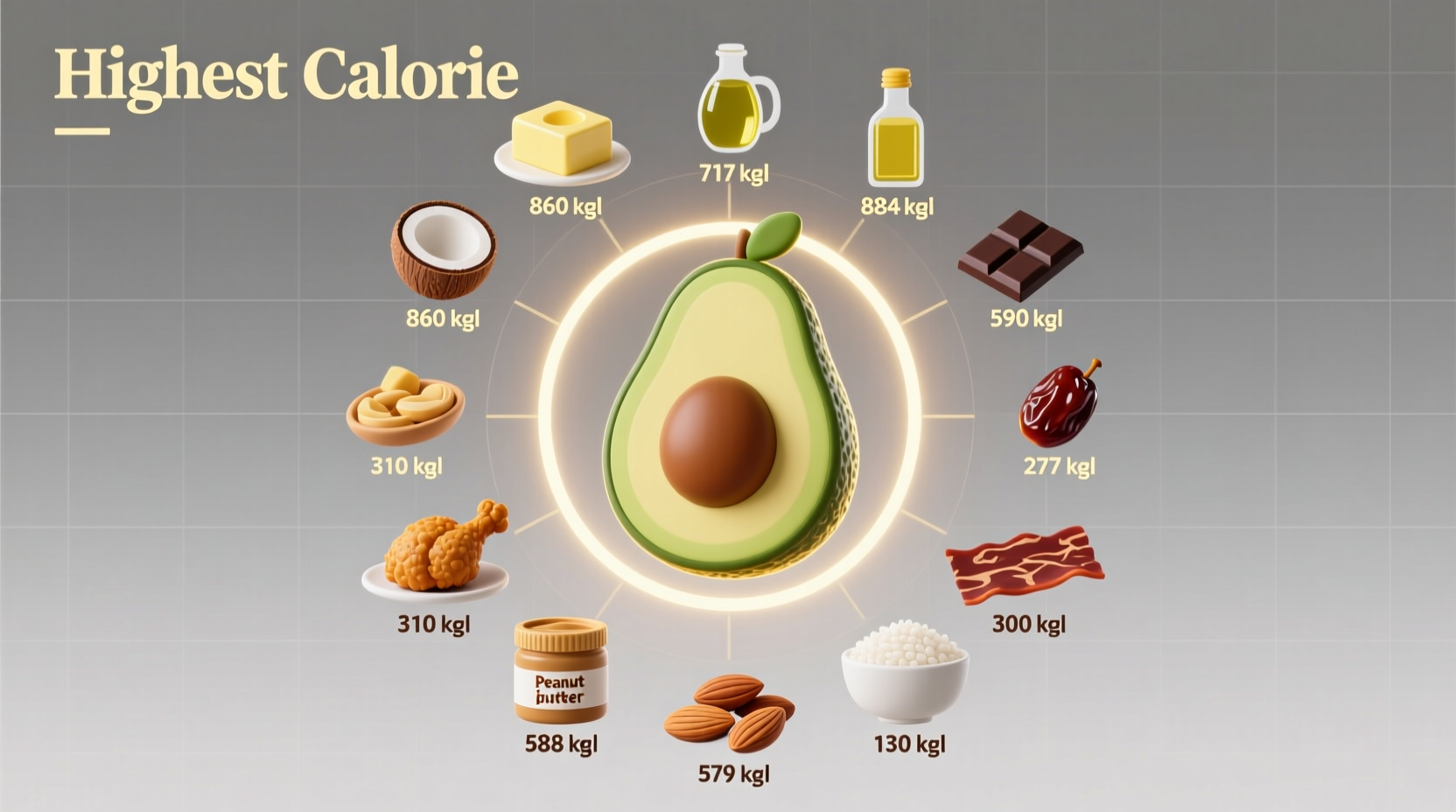Pure fats and oils contain the highest calories per serving, with olive oil providing approximately 119 calories per tablespoon (14g). Among solid foods, dried coconut (283 calories per ounce), dark chocolate (70-85% cocoa), and certain nuts like walnuts (185 calories per ounce) rank highest in calorie density according to USDA FoodData Central.
When searching for calorie-dense foods, it's crucial to understand both the numbers and their context. Whether you're an athlete needing extra energy, someone recovering from illness, or simply curious about food science, knowing which foods pack the most calories per bite can inform smarter dietary choices. This guide examines the science behind calorie density, identifies the most energy-concentrated foods with verified data, and explains when these foods serve beneficial purposes versus when they might require moderation.
The Science Behind Calorie Density
Calorie density measures how many calories exist in a given weight of food. Understanding this concept reveals why certain foods naturally contain more energy:
- Fats deliver 9 calories per gram—more than double the energy of proteins or carbohydrates (4 calories per gram)
- Foods with high water content (like fruits and vegetables) naturally have lower calorie density
- Processing methods like drying fruits or extracting oils concentrate calories by removing water
This scientific principle explains why pure fats top the calorie charts. When water and other non-caloric components are removed, the energy concentration increases dramatically.
Top Calorie-Dense Foods: Verified Data Comparison
Based on USDA FoodData Central measurements, these foods deliver the highest calories per standard serving. The table below shows calorie density across categories:
| Food | Calories per Ounce (28g) | Primary Calorie Source | Nutrient Density Score |
|---|---|---|---|
| Dried coconut | 283 | Fat (82%) | Moderate |
| Walnuts | 185 | Fat (76%) | High |
| Dark chocolate (70-85% cocoa) | 170 | Fat (60%), Carbs (35%) | Moderate |
| Almonds | 164 | Fat (74%) | High |
| Olive oil (per tbsp) | 119 | Fat (100%) | Low |
This comparison reveals an important distinction: while pure fats like oils have the highest absolute calorie counts, many high-calorie whole foods also deliver valuable nutrients. Walnuts and almonds, for instance, provide healthy fats, protein, and fiber alongside their calories—a significant advantage over nutritionally empty high-calorie options.
Context Matters: When High-Calorie Foods Serve a Purpose
The National Institutes of Health recognizes specific scenarios where calorie-dense foods provide essential benefits:
- Medical recovery: Patients recovering from surgery or illness often need concentrated calories when appetite is limited
- High-performance athletics: Endurance athletes may require 3,000-6,000 daily calories during training periods
- Underweight individuals: Those with difficulty gaining weight can benefit from nutrient-rich high-calorie foods
- Cold climate adaptation: Traditional diets in Arctic regions naturally feature high-fat foods for thermoregulation
According to research published in the American Journal of Clinical Nutrition, populations in circumpolar regions historically consumed diets where 50-75% of calories came from fat—primarily from marine mammals and fish. This adaptation demonstrates how calorie density serves practical purposes in specific environmental contexts.

Practical Guidance for Everyday Consumption
For most adults maintaining a healthy weight, the Centers for Disease Control and Prevention recommends focusing on nutrient density rather than pure calorie concentration. Consider these evidence-based strategies:
- Portion awareness: Use tablespoons instead of eating straight from containers for high-calorie items like nut butters
- Balanced additions: Sprinkle nuts on salads rather than eating them by the handful to gain benefits without excess
- Smart substitutions: Replace processed high-calorie foods with whole food alternatives (avocado instead of mayonnaise)
- Timing matters: Consume calorie-dense foods around physical activity when energy demands are highest
The Academy of Nutrition and Dietetics emphasizes that no food is inherently "good" or "bad"—context and quantity determine nutritional value. A tablespoon of olive oil provides valuable monounsaturated fats, while the same amount of butter delivers mostly saturated fat with fewer additional nutrients.
Common Misconceptions About High-Calorie Foods
Many people operate under incorrect assumptions about calorie-dense foods:
- Myth: All high-calorie foods are unhealthy
Reality: Avocados, nuts, and seeds deliver healthy fats alongside vitamins and minerals - Myth: Calorie counting is the only important factor
Reality: Nutrient density, satiety value, and metabolic effects matter equally - Myth: High-calorie foods automatically cause weight gain
Reality: Total daily energy balance determines weight changes, not individual foods
Research from Harvard's T.H. Chan School of Public Health shows that people who regularly consume nuts actually have lower obesity rates than those who avoid them—demonstrating that food quality matters more than calorie count alone.
When Calorie Density Becomes Problematic
While some high-calorie foods offer nutritional benefits, others present concerns. Ultra-processed foods often combine high calorie density with low nutrient content and engineered hyper-palatability. The FDA's food labeling guidelines help identify these products through their ingredient lists and nutrition facts panels.
Be particularly cautious with foods that combine high fat and high sugar—a combination rarely found in nature that can override natural satiety signals. Examples include many baked goods, ice creams, and processed snack foods.
Conclusion: Finding Your Calorie Balance
Understanding which foods contain the highest calories provides valuable knowledge for making informed dietary choices. Whether you're seeking to gain weight healthfully, optimize athletic performance, or simply understand food composition better, focusing on nutrient-rich high-calorie options delivers the best results. Remember that individual calorie needs vary significantly based on age, sex, activity level, and health status—consulting a registered dietitian can help determine your personal requirements.











 浙公网安备
33010002000092号
浙公网安备
33010002000092号 浙B2-20120091-4
浙B2-20120091-4